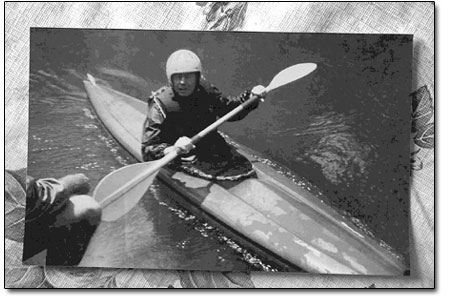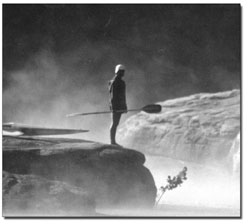|
| ||||
| The first strokes SideStory: Animas River Days at a glance
by Will Sands
Kent Ford – world champion kayaker, award-winning videographer and one of the most recognizable names in boating – logged thousands of hours over many years to produce his latest release, “The Call of the River.” The film is a both departure and arrival for Ford, whose company, Performance Video, specializes in whitewater instruction and boasts nearly 20 titles as evidence. In beginning the ambitious effort, Ford set out to accomplish something different – a comprehensive look at whitewater boating’s beginnings, roots and evolution. “I was intrigued by doing something that tied together the history and made good use of the amazing archival footage,” Ford says. “The result is pretty unique. ‘The Call of the River’ is really the first film that builds the bridge and ties it all together. From beginning to end, you see the sport unfold.” Using archival footage and interviews with eclectic pioneers, Ford captured the world of whitewater from its early beginnings to its position as a major outdoor sport in the world today. When Ford looked for the beginning, he went back as far as possible. The film opens with a look at North American river travel prior to the arrival of Europeans. However, rather than launch into an exhaustive historical survey, Ford turns to colored commentary from modern day river pioneers – “There were some phenomenal designs … They had whitewater boats, touring boats … .” The film moves into the 20th century by taking viewers on whitewater trips in fragile canvas canoes with shirtless daredevils and details Reg Bloomfield’s flatwater canoe stunts (“That guy was like a fish,” Ford chuckles). In this era, the advent of the aluminum canoe marked a major leap forward in whitewater boating. Following World War II, Grumman Aviation put its presses and workers into the boat business, and summer camps and rivers everywhere were soon inundated with the metal craft. “You were immediately fast friends on the river,” river pioneer Jimmy Holcombe says of those times. “You might need to be. People didn’t blow anyone off. There was a lot more carnage.” Early boater Bert Hinkley adds, “We were told that the river was dangerous, that people died on the river, that we were crazy, but it looked good to us.”
The advent of the hardshell kayak marked another milestone for whitewater boating. Dabbling in “the alchemy of the times,” desperate boaters would mix up a toxic epoxy brew, stack layers of fiberglass together and build their own boats in basements all over the nation. These same boaters would seize on a different type of alchemy and desperately search for flows, often bribing dam keepers with beer in order to temporarily open the flood gates. “The kayak was really our inspiration to continue,” says Joe Pulliam, founder of Dagger. “We’d already started paddling canoes, but boy that kayak thing looked good.” Ford also unveils footage from the inaugural FIBArk race on the Arkansas River near Salida in 1949. What started as a way for the beleaguered small town to sell real estate soon evolved into the biggest whitewater event in the world at the time. “After a wave from the boat race queen, he’s on his way,” the classic footage relates. The film “Deliverance,” remembered the world over for bringing backwoods romance to the screen, also brought river running to mainstream audiences for the first time. Combined with slalom boating’s inclusion in the 1972 Olympics and the advent of the plastic Hollowform kayak, the film helped trigger an explosion in paddling’s popularity. “Deliverance” not only “delivered an inspired audience to the banks of the nation’s rivers,” it set off a frenzy of reckless paddling in questionable rivercraft. Helped by mass production and marketing by the company Perception, the sport’s commercialization followed. The Perception Dancer, “the first real playboat,” eventually came on the scene, and hundreds of thousands were sold. However, whitewater boating’s soul remained intact. Eric Jackson, whitewater legend and owner of Jackson Kayaks, nails the sentiment, saying, “It’s been 30 years since I did my first ender, and I remember it like it was yesterday.” And the filmmaker certainly shares the feeling. “One of the huge of implications of this project was really telling a national story,” Ford says. “But really the story tells itself because there are so many interesting characters and milestones involved.” • More on “The Call of the River,” including a preview trailer, stills and synopsis is available online at www.thecalloftheriver.com.
|
In this week's issue...
- May 15, 2025
- End of the trail
Despite tariff pause, Colorado bike company can’t hang on through supply chain chaos
- May 8, 2025
- Shared pain
Dismal trend highlights need to cut usage in Upper Basin, too
- April 24, 2025
- A tale of two bills
Nuclear gets all the hype, but optimizing infrastructure will have bigger impact



 It’s been a long, strange river trip. From birch bark and cross-bow beginnings, whitewater boating has matured into a modern day, rotomolded reality. And for the first time ever, a Durango paddling legend and filmmaker has chronicled the birth and evolution of whitewater boating on film.
It’s been a long, strange river trip. From birch bark and cross-bow beginnings, whitewater boating has matured into a modern day, rotomolded reality. And for the first time ever, a Durango paddling legend and filmmaker has chronicled the birth and evolution of whitewater boating on film.